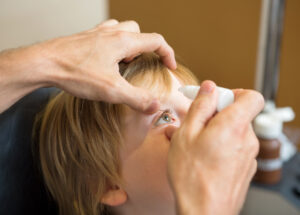March 1, 2023
By Peter (Zhi) Chen, MD, PhD, Fudan University Eye and ENT Hospital, Shanghai, China
Low-concentration atropine is needed only when children undergoing optical interventions such as OrthoK experience fast progression. Novel OrthoK lens designs that induce a smaller and more aspheric treatment zone may be great alternatives to conventional lens designs to enhance the myopia management efficacy.
 Orthokeratology, an effective myopia management strategy, is said to be prescribed to over two million children and adolescents in China. In a recent survey conducted in China, over 80% of the parents considered OrthoK to be a modality for myopia management rather than just for myopia correction (Xie P, Current situation of orthokeratology practice in China, SMILE Vision Symposium, Shanghai, January 2023).
Orthokeratology, an effective myopia management strategy, is said to be prescribed to over two million children and adolescents in China. In a recent survey conducted in China, over 80% of the parents considered OrthoK to be a modality for myopia management rather than just for myopia correction (Xie P, Current situation of orthokeratology practice in China, SMILE Vision Symposium, Shanghai, January 2023).
Evidence from numerous well-designed studies indicates that OrthoK slows myopic progression and axial elongation by 30% to 60%.1 Despite the promising evidence for myopia control with OrthoK, a certain proportion of patients continue to exhibit significant progression with OrthoK treatment, and younger children typically experience faster progression compared to their older counterparts. What can the practitioner do if faced with such a situation? Is it possible to add an adjunct treatment strategy to enhance efficacy? In this regard, some research already suggests that optical strategies may be combined with a pharmaceutical agent, such as low-concentration atropine, to boost efficacy. Since low concentration atropine is considered to provide a moderate treatment effect with minimal side effects, should atropine be prescribed for all children wearing OrthoK for myopia management?
Before accepting that premise, the following three questions must be answered:
1. Does the Strategy Work?
Likely, at least in the short term. In studies that investigated the add-on effect of atropine on fast progressors (defined as axial elongation >0.30 mm/year with OrthoK treatment), the addition of atropine significantly slowed axial elongation from an average of 0.45 mm/year to 0.16 mm/year. However, after one year of combined treatment, the effect of atropine tapered off over the next year, yielding no difference between the combined treatment group and the OrthoK-only control group over a total of three years.2
Two randomized controlled trials conducted in Japan and Hong Kong both revealed a significant adjunctive treatment effect of OrthoK and atropine in slowing axial elongation, as compared to OrthoK alone.3,4 Yet in these two studies, atropine seems to work in the earlier phase of the study only, evidenced by similar axial elongation trajectory between the two groups one year or even six months after commencement of treatment. A possible explanation for the “dampening” effect of atropine over time is that atropine use increases choroidal thickness in the short term, returning to baseline levels in the long term. In addition, the rebound effect of add-on atropine treatment has not been tested.
2. Is it Safe?
Yes, in most cases. Severe side effects such as allergy and photophobia with higher-concentration atropine are rarely reported with low-concentration atropine. Adjunctive treatment with low-concentration atropine does not seem to increase the likelihood of side effects. However, as with any other pharmaceutical treatments, the long-term cumulative side effects of using a non-selective muscarinic receptor antagonist such as atropine are challenging to evaluate. Long-term treatment with such medication should be avoided unless necessary.
Want more information on OrthoK?
3. Are There Alternatives?
Yes, there are. One hypothesis of atropine’s add-on effect is that low-concentration atropine slightly enlarges the pupil size of the patient undergoing OrthoK therapy, thereby increasing the proportion of peripheral myopic defocus penetrating through the pupil margin and enhancing the myopic control efficacy of OrthoK.5 Based on the same premise, a modification to the optical design of the OrthoK lenses and the consequent corneal refractive power distribution within the treatment zone may also impact myopia progression.
Indeed, a modification to the OrthoK lens design, e.g., using a smaller back optic zone, effectively changes the corneal power distribution. As measured by corneal topography, a smaller and more aspheric treatment zone is rendered possible with these lens designs. These innovative lens designs have shown promise in slowing axial elongation compared to conventional OrthoK lens designs.6,7 Children undergoing treatment with these lens designs generally do not complain about the visual quality issues like young adults. Instead, they show considerable tolerance to the halo, glare, and hazy vision associated with a smaller treatment zone. Therefore, it is likely that these innovative lenses will become the norm in OrthoK practice in the future, given that most of the OrthoK lenses for children are prescribed for myopia management.
To conclude, I do not advise using low-concentration atropine as an add-on treatment for all OrthoK cases. Low-concentration atropine is needed only when children undergoing optical interventions such as OrthoK experience fast progression. To decrease the likelihood of potential long-term side effects, atropine should be used cautiously and preferably over a short term, e.g., one year. Novel OrthoK lens designs that induce a smaller and more aspheric treatment zone may be great alternatives to conventional lens designs to enhance the myopia management efficacy.
 |
Dr. Zhi (Peter) Chen is an ophthalmologist from Fudan University Eye and ENT Hospital in Shanghai, China. He completed his joint PhD program with Fudan University and the University of California Berkeley in 2013. He became a Fellow of the International Academy of Orthokeratology and Myopia Control (FIAOMC) in 2018 and is the leading member of the Shanghai Orthokeratology Study (SOS) group. He has published over 40 research papers associated with OrthoK and myopia control. He’s been invited to lecture both nationwide and overseas to share his research and experience in myopia management. |
References
- Wildsoet CF, Chia A, Cho P, et al. IMI – Interventions Myopia Institute: Interventions for Controlling Myopia Onset and Progression Report. Invest Ophthalmol Vis Sci 2019;60:M106-m131.
- Chen Z, Zhou J, Xue F, Qu X, Zhou X. Two-year add-on effect of using low concentration atropine in poor responders of orthokeratology in myopic children. Br J Ophthalmol 2022;106:1069-1072.
- Kinoshita N, Konno Y, Hamada N, et al. Efficacy of combined orthokeratology and 0.01% atropine solution for slowing axial elongation in children with myopia: a 2-year randomised trial. Sci Rep 2020;10:12750.
- Tan Q, Ng AL, Choy BN, Cheng GP, Woo VC, Cho P. One-year results of 0.01% atropine with orthokeratology (AOK) study: a randomised clinical trial. Ophthalmic Physiol Opt 2020;40:557-566.
- Kinoshita N, Konno Y, Hamada N, Kanda Y, Shimmura-Tomita M, Kakehashi A. Additive effects of orthokeratology and atropine 0.01% ophthalmic solution in slowing axial elongation in children with myopia: first year results. Jpn J Ophthalmol 2018;62:544-553.
- Guo B, Cheung SW, Kojima R, Cho P. One-year results of the Variation of Orthokeratology Lens Treatment Zone (VOLTZ) Study: a prospective randomised clinical trial. Ophthalmic Physiol Opt 2021;41:702-714.
- Pauné J, Fonts S, Rodríguez L, Queirós A. The Role of Back Optic Zone Diameter in Myopia Control with Orthokeratology Lenses. J Clin Med 2021;10.













